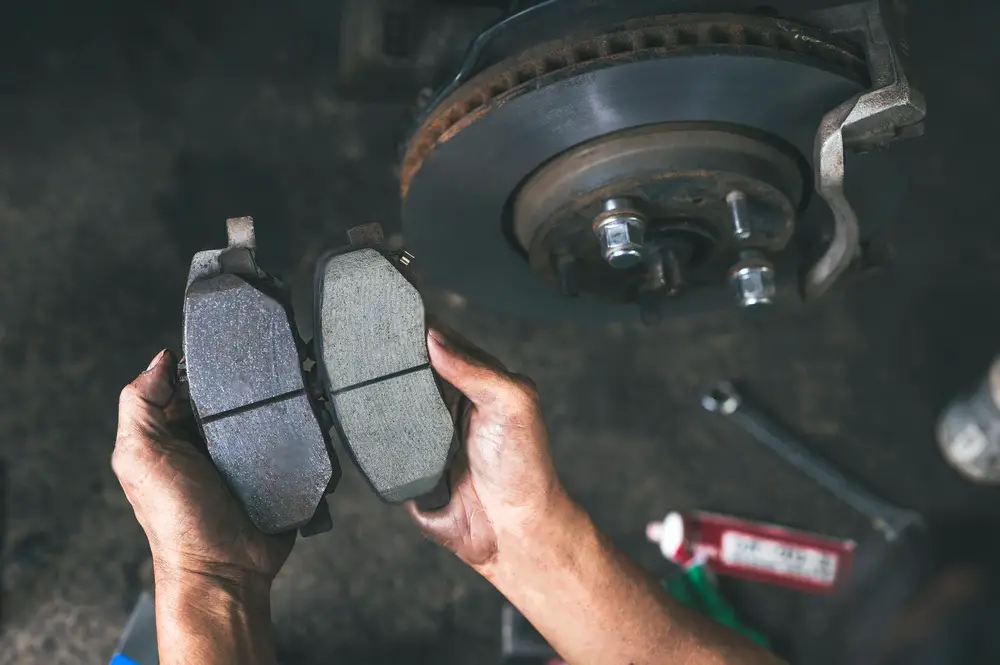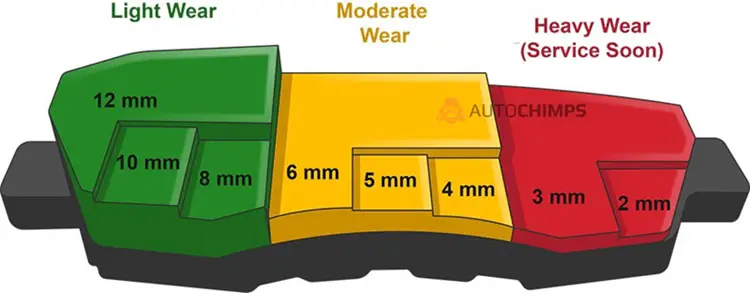Brake pads should be replaced when they wear down to 3 mm. New pads are typically 10-12 mm thick, and waiting until they reach 1-2 mm can reduce braking performance and risk rotor damage.
Brake pad thickness is a critical indicator of when your brakes need replacement to ensure safe driving. As brake pads wear down over time, their ability to provide adequate friction and stopping power decreases. Monitoring their thickness and replacing them at the right time. Typically brake pad thickness for replacement is 3 mm is essential to maintaining the vehicle’s braking efficiency and preventing damage to other components.

Contents
Why Brake Pad Thickness is Important
Brake pads are responsible for creating the friction needed to slow down and stop your vehicle. As you press on the brake pedal, the brake calipers squeeze the pads against the brake rotors, generating the friction that stops your car. Over time, the material on the brake pads wears down, reducing their thickness and, consequently, their ability to function effectively.
- Thinner brake pads = less friction: As the brake pads become thinner, they generate less friction against the rotor, leading to longer stopping distances and reduced control.
- Heat dissipation: Brake pads also dissipate the heat generated during braking. Thinner pads have less material to absorb and dissipate heat, increasing the risk of brake fade (reduced braking power due to overheating).
- Structural integrity: Brake pads that are too thin can crack, crumble, or even break apart, leading to potential damage to other braking components like the rotors.
What is Considered Safe Brake Pad Thickness?
New brake pads usually come with a thickness of 10 to 12 millimeters (mm), depending on the type and brand of pads. Over time, this thickness decreases as the material wears down with regular use. It’s crucial to know when the pads have worn to a level that requires replacement to ensure safe braking performance.
Here’s a general guideline for brake pad thickness:
- New Brake Pads: 10-12 mm
- Good Condition: 8-10 mm
- Fair Condition (Monitor Closely): 3-4 mm
- Dangerous (Replace Immediately): 1-2 mm
While some vehicles may have brake pads with different initial thicknesses, these ranges offer a good rule of thumb. Once your brake pads reach around 3-4 mm, it’s time to start considering a replacement.
Minimum Brake Pad Thickness for Replacement
The minimum brake pad thickness for replacement typically varies depending on the manufacturer and type of vehicle. However, a general guideline for most vehicles is that brake pads should be replaced when they wear down to 3 mm (0.12 inches) or less. Here are a few key points to consider:
1. General Rule of Thumb
Most mechanics agree that brake pads should be replaced when they reach a thickness of 3 mm. This provides a good safety margin before the brake pad material becomes too thin to function effectively.
2. Legal Minimum Thickness
In many regions, brake pads must meet a legal minimum thickness requirement. For instance, in some U.S. states and European countries, 2 mm is considered the absolute minimum. However, waiting until the pads are 2 mm thick can be risky, as the reduced material can significantly affect braking performance.
3. Recommended Replacement Thickness
To ensure optimal performance, most manufacturers recommend replacing brake pads at 3-4 mm. At this thickness, the pads are still capable of providing adequate stopping power, but you are approaching the point where wear will accelerate, and braking performance will begin to decline.

How to Measure Brake Pad Thickness
If you’re unsure about the current state of your brake pads, you can check their thickness with a few simple methods:
1. Visual Inspection: If you can see your brake pads through the wheel spokes, take a look at them. If the pads appear thinner than 3-4 mm, it’s time for a replacement. However, depending on your car, the brake calipers may obscure the view, making it difficult to get an accurate assessment.
2. Use a Brake Pad Gauge:
For a more precise measurement, you can use a brake pad thickness gauge. This tool allows you to measure the remaining pad material without removing the wheel.
3. Professional Inspection: If you’re not comfortable checking the brake pads yourself, a professional mechanic can measure the pad thickness and assess their condition during a routine maintenance check.
Frequently Asked Questions
Here are some FAQs about brake pad thickness –
1. How often should I check my brake pad thickness?
It’s a good idea to check your brake pad thickness every 6 months or during routine tire rotations. If you notice any signs of brake wear, such as squeaking or longer stopping distances, inspect them sooner.
2. Can I drive with thin brake pads?
Driving with brake pads thinner than 3 mm can be dangerous, as they offer reduced stopping power and may overheat quickly. It’s best to replace them as soon as they approach 3 mm in thickness.
3. Do front brake pads wear faster than rear pads?
Yes, front brake pads typically wear out faster than rear pads because the front brakes handle most of the vehicle’s braking force, especially during sudden stops.
4. What happens if I don’t replace my brake pads on time?
If you don’t replace worn brake pads, they can damage other components of the braking system, such as the rotors, leading to more expensive repairs. Additionally, your car’s stopping distance will increase, compromising safety.
5. Can brake pads wear out unevenly?
Yes, brake pads can wear unevenly due to issues such as misaligned brake calipers or stuck brake pistons. If you notice uneven wear, have a mechanic inspect the braking system to diagnose and fix the issue.
Conclusion
Brake pad thickness is an essential factor in vehicle safety and performance. Regularly monitoring your brake pads and replacing them before they become too thin ensures that your car maintains optimal braking power. By staying vigilant and following the guidelines outlined in this post, you can keep your vehicle’s braking system in top shape, reduce the risk of costly repairs, and, most importantly, stay safe on the road.